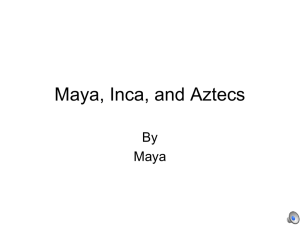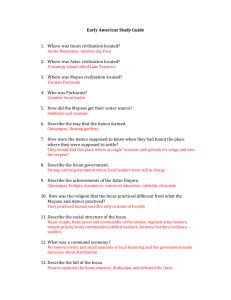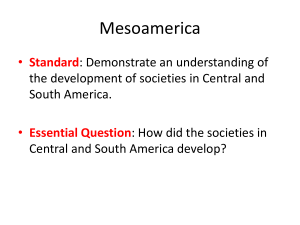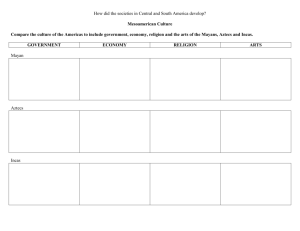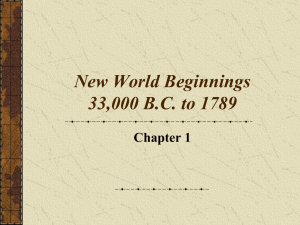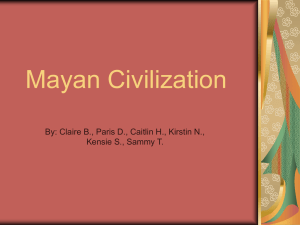Latin America - misskimelewskisclass
advertisement
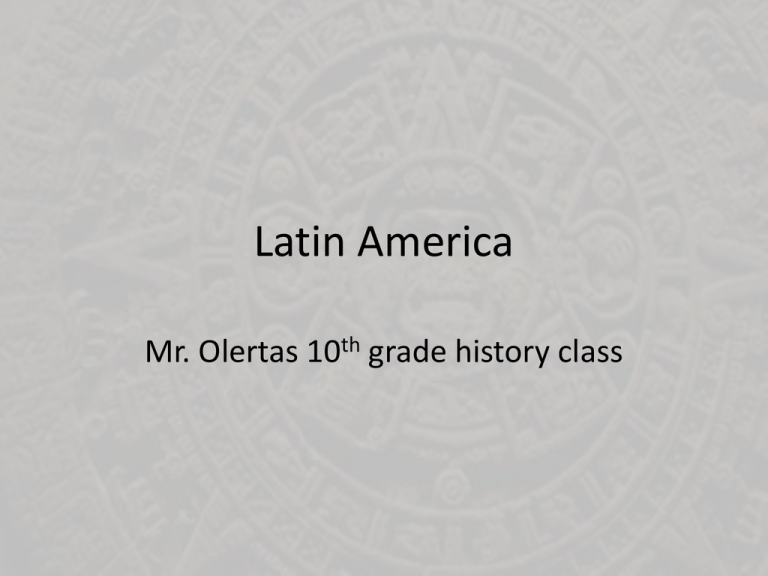
Latin America Mr. Olertas 10th grade history class Climates • Tropical climates • Three fourths of Latin America lies in the tropics • The warm temperature and heavy rainfall allows support for Rain forest • Mexico contains some dry climates Elevation • In much of Latin America, the chief influence on climate is elevation above sea level • Tierra Caliente – is closest to sea level, these lowlands offer tropical crops a place to flourish • Tierra Templada – includes areas that lie above 3,000 feet. The days are hot, but the nights are cool. Many cities are found in this zone, and coffee and tobacco crops thrive at this altitude Elevation Cont. • Tierra Fria- cold land. This land includes places at least 6,000 feet above sea level. Night time is very cool and winter temperatures can occur. Farmers who live in this zone grow wheat, barley, and potato's Natural Resources • Latin America is rich in natural resources • Most Latin Americans have not benefited from the vast resources due the the fact that people exploited these resources in order to promote their own interests • These people where both Spanish and wealthy ruling groups Natural Resources Cont. • Minerals- Gold and silver are the minerals that lured many Europeans to the Americas. Also copper, tin, and bauxite are found each year • Energy resources – Some countries have an abundant supply of oil and natural gas. Due to heavy rains, countries like Mexico and Paraguay have harnessed the force of these rivers to produce hydroelectric power Natural Resources Cont. • Agricultural Resources – The economies of Latin American countries depend on cash crops People of Latin America • Native Americans were the original people who inhabited Latin America. • After 1492, Europeans began to settle in Latin America. • Through the slave trade, many Africans where brought over to the central Americas for slavery Population Patterns • Many people are not settled in rigid mountain sides and severely high climate due to the limited farmland that can be produced. • Another factor is the limited communication like high mountains or limited contact between people in coastal areas Mayans • Mayans lived in a dense lowland rain forest • Lived between A.D 300 and A.D 900 • Had roads that connected cities from Guatemala all the way to Mexico • Merchants traded cotton cloth as well jewelry • They also shipped goods to other distant locations in ocean going canoes Mayan Farming • Mayans had to use complex farming techniques to farm the difficult lands • Mayans cleared dense forests and built raised fields for crops • If too much rain fell, farmers opened channels to drain fields • These techniques fed all of the cities, and also created a surplus to feed cities Mayan Government/Society • Each Mayan city had its own government • At the top was a king who was the most important military and religious leader • Below the king was nobles and priests who helped govern the city • Merchants and artisans where next in the social order, but had no government power yet supplied nobles with fine goods • The largest group of people were peasants and laborers but they were lower then everyone but slaves Mayan Religion/Achievements • Polytheistic religion • The Mayans would build different temples for gods, these buildings were huge • The buildings that Mayans Built represented their skill in architecture • Mayan priests were also great astronomers • They made a successful calendar that told farmers when exactly to plant crops Aztecs • Aztecs built advanced civilizations North of the Mayans • Began around 1200 A.D • Used many ideas absorbed from the Mayans • For example they learned how to build temples and pyramids Aztec Government • Aztecs only had one king • He was chosen by priests, nobles, and warriors • When Aztecs would conquer other city-states they would leave the leadership in place but they had to pay a tribute • They would take captives though, and made some slaves but most were used as sacrifices to the gods Aztec Religion • Polytheistic • Priests guarded many of the temples dedicated to gods • Priests were the only ones who performed rituals to please the gods • Priests also recorded knowledge of science, math, and medicine Tenochtitlan • The bustling city at the heart of the Aztec Empire • By 1500 it was the home to 150,000 people • To feed the city the Aztecs developed ways to farm the swampy land of lake texcoco • Merchants sold goods in the busy central market Aztec Education and Women • Educated both boys and girls • Studied history and religion • Guys learned about war while girls learned about home making skills • Aztec women could own property • Also they could remarry if the husband died Incas • Found on the west coast of South America • Built a vast empire • By the Late 1400’s, the Inca Empire stretched 2,500 miles Farming • Incas were able to feed a population of 9 million • They had skilled farming methods • They learned to build Irrigation Systems • Also acquired the knowledge of fertilizer • Crops like Corn, potatoes, and beans flourished Religion • Polytheistic • The highest god was the Sun God • The temple of the sun was the center of Inca Worship in Cuzco • Gold was considered the sweat of the gods • Priests and priestesses performed ceremonies in honor of the sun god Government • Inca had an Emperor who owned everything • He ruled with the aid of nobles and priests • Officials told people where to live and what to do • Would give farmers land but put a taxes on crops Fall of the Incas • Pizzaro a Spanish explorer heard about the wealth in the Incas and decided to conquer it • Ended up destroying the empire through force and the spread of European disease • Destroyed a lot of Incan books and other important historical items

